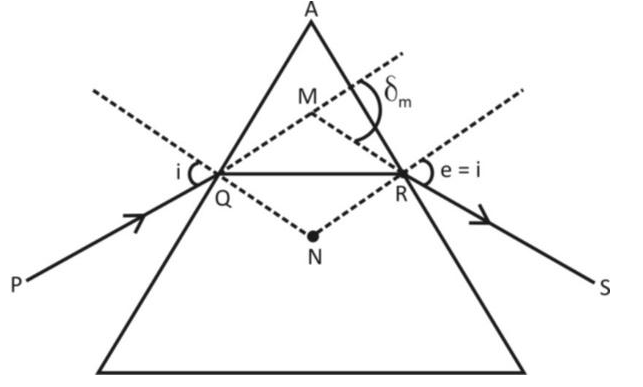
For the refraction of light through a prism
(A) For every angle of deviation there are two angles of incidence
(B) The light travelling inside an equilateral prism is necessarily parallel to the base when prism is set for minimum deviation
(C) There are two angles of incidence for maximum deviation
(D) Angle of minimum deviation will increase if refractive index of prism is increased keeping the outside medium unchanged if $ {\mu _p} > {\mu _s} $
Answer
503.4k+ views
Hint :In order to solve this question, we are going to first draw the ray diagram for the refraction of light through a prism. After that, some of the phenomena or the observations made in this case are discussed and finally the correct option(s) is/are chosen from the above.
Complete Step By Step Answer:
For the refraction of light through a prism, we have the following phenomenon observed.
Let us first draw a diagram for the refraction of light through prism.

For every angle of deviation, we have two angles of the incidence.
The light ray that is travelling inside of an isosceles prism is necessarily parallel to the base when the prism is set for the minimum deviation.
For the maximum deviation, there are two angles of the incidence.
If the outside medium remains the same, and the material of the prism is changed such that its refractive index also changes, then, the angle of the minimum deviation will increase.
Hence, from the above observations, we get that the options(C) and (D) are the correct answers.
Note :
The ray of light gets deviated two times simply when entering the prism and while leaving it too which is because the two refracting surfaces of the prism are not parallel. The light ray travelling from the rarer to the denser medium gets refracted and bends towards the normal and vice versa.
Complete Step By Step Answer:
For the refraction of light through a prism, we have the following phenomenon observed.
Let us first draw a diagram for the refraction of light through prism.

For every angle of deviation, we have two angles of the incidence.
The light ray that is travelling inside of an isosceles prism is necessarily parallel to the base when the prism is set for the minimum deviation.
For the maximum deviation, there are two angles of the incidence.
If the outside medium remains the same, and the material of the prism is changed such that its refractive index also changes, then, the angle of the minimum deviation will increase.
Hence, from the above observations, we get that the options(C) and (D) are the correct answers.
Note :
The ray of light gets deviated two times simply when entering the prism and while leaving it too which is because the two refracting surfaces of the prism are not parallel. The light ray travelling from the rarer to the denser medium gets refracted and bends towards the normal and vice versa.
Recently Updated Pages
Master Class 12 English: Engaging Questions & Answers for Success

Master Class 12 Business Studies: Engaging Questions & Answers for Success

Master Class 12 Economics: Engaging Questions & Answers for Success

Master Class 12 Social Science: Engaging Questions & Answers for Success

Master Class 12 Maths: Engaging Questions & Answers for Success

Master Class 12 Chemistry: Engaging Questions & Answers for Success

Trending doubts
What are the major means of transport Explain each class 12 social science CBSE

Which are the Top 10 Largest Countries of the World?

Draw a labelled sketch of the human eye class 12 physics CBSE

Explain sex determination in humans with line diag class 12 biology CBSE

Explain sex determination in humans with the help of class 12 biology CBSE

Differentiate between homogeneous and heterogeneous class 12 chemistry CBSE




